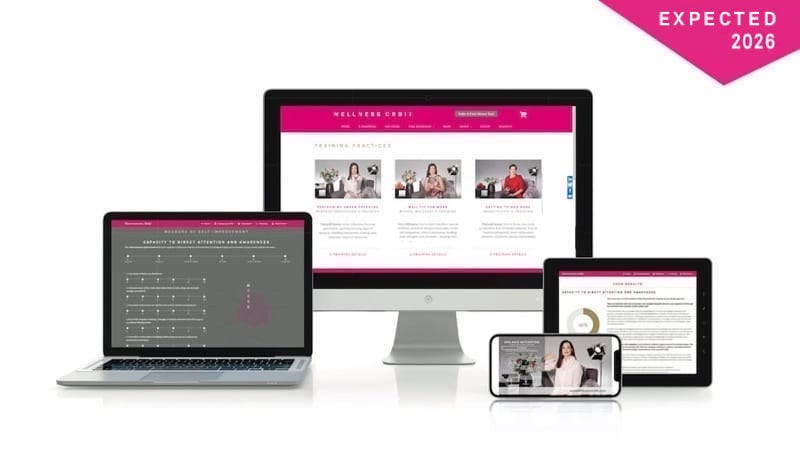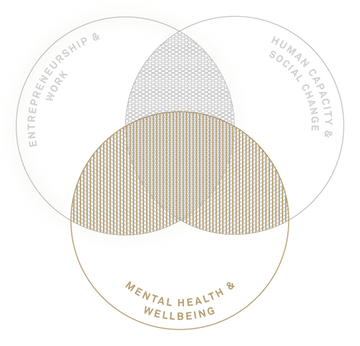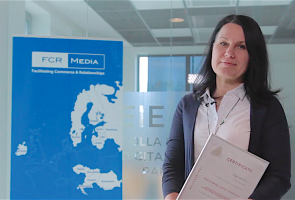DEAL WITH ANXIETY Expected release: 2026

AT A GLANCE – UNDERSTANDING ANXIETY
“Mental health was the great taboo. If you were anxious, it’s because you were weak. If you couldn’t cope with whatever life threw at you, it’s because you were failing. Successful, strong people don’t suffer like that, do they? But of course – we all do. It’s just that few of us speak about it.” – Prince William, The Duke of Cambridge
ANXIETY REDUCTION ONLINE TRAINING
Training one's own awareness aims to impact emotion regulation. Generalized anxiety symptoms can be successfully addressed through awareness-based interventions.
Individuals with anxiety show deficits in emotion regulation (Tull et al., 2009). Anxiety is also associated with negative thinking, sleep problems and even muscle tension. Awareness-based interventions, which focus on directing attention to present moment experiences, directly address such deficits and allow us to notice how to solve the challenges.
Research has reliably detected increases in connectivity between the amygdala and several regions of the prefrontal cortex after awareness practices.
With guided awareness practices, people can discover a more adaptive strategy to regulate emotions. Awareness improves inner self-observation and results in better self-leadership skills.
Awareness practice involves observing physical and emotional responses with an accepting attitude, as opposed to acting out or suppressing emotions. Not knowing how to deal with worry, anxiousness, and stress that are leading people slowly towards anxiety.
WHAT IS THE DIFFERENCE BETWEEN ANXIOUSNESS AND ANXIETY?
Although we all may experience some anxiousness from time to time, it is not anxiety.
Common anxiety signs and symptoms include (several of the listed usually exist at the same time):
- Feeling nervous, restless or tense for longer periods;
- Having a sense of impending danger, panic or doom when there is no actual reason for it;
- Having an increased heart rate and/or breathing rapidly (hyperventilation);
- Sweating or trembling;
- Feeling weak or tired for a longer period;
- Experiencing trouble focusing and keeping concentration on the actual task at hand;
- Thinking constantly about what might happen and having difficulty controlling worry;
- Having trouble sleeping peacefully;
- Experiencing gastrointestinal (GI) problems;
- Having a strong urge to avoid people, things, locations and events that trigger anxiousness.
Different studies have convincingly demonstrated that enhanced connectivity between several brain regions is crucial to successful emotion regulation, both for healthy and anxious people. When you know how to lead your inner processes, life becomes easier and less worrisome, this is why intrapersonal education matters.
BENEFITS FOR THE EMPLOYERS:
► Enhances employee intrapersonal wellness and emotional resilience at work;
► Employees gain access to awareness-based intrapersonal skills to self-regulate emotions;
► People learn to address their different fears: fear of flying, speaking up, looking stupid, etc.;
► Employees learn to deal with the fear of uncertainty - the main fear when facing change;
► Training provides staff with methods for being in charge of how they feel and behave;
► Delivers a springboard for innovation - not to let fear or naysayers stop people with good ideas.
The content of this anxiety online course is mental wellness focused training that gives you a better ability to relax and let go of your worries. This anxiety e-learning content is subject to change as it is still under development.

For now, you are most welcome to explore our other mental wellness online training options. After all, prevention is better than cure.
REDUCE ANXIOUSNESS BY BECOMING MORE PRESENT
Meanwhile, we recommend you take the most general mental wellness course we have – "Well Fit For Work". This unique online course enables you to understand mental wellness in a work-related context and be more present. And best of all, it also includes an easy guided relaxation exercise with Dr. Helena Lass that you can use daily.
You will learn: how to deal with anxiousness, fear, resistance and discomfort, spotting warning signs and symptoms, the importance of treatment and intervention
You will solve: stress and anxiety-related mental health problems at work

Category: Intrapersonal Skills for Mental Health & Wellbeing
THIS MENTAL WELLNESS ONLINE TRAINING WILL INCLUDE:
► A start "spider" to evaluate participants individual status before the training;
► 5 mental health training session videos:
Session 1: What is Happening & Why
Session 2: The Anxious "Habits" of the Brain
Session 3: Roots of Fear. Awareness of Emotions
Session 4: Addressing the Thoughts of Worry
Session 5: Facing New Situations and Challenges
► Quiz to consolidate the learned.
► Workbook (incl. group discussion guidelines).
► Promotional materials + certificate.
► A final "spider" to evaluate participants individual status after the training.
► Alumni discussion group (incl. possibility to ask questions after the training).
This free offer is valid for the next:
AT A GLANCE – UNDERSTANDING ANXIETY
“Mental health was the great taboo. If you were anxious, it’s because you were weak. If you couldn’t cope with whatever life threw at you, it’s because you were failing. Successful, strong people don’t suffer like that, do they? But of course – we all do. It’s just that few of us speak about it.” – Prince William, The Duke of Cambridge
ANXIETY REDUCTION ONLINE TRAINING
Training one's own awareness aims to impact emotion regulation. Generalized anxiety symptoms can be successfully addressed through awareness-based interventions.
Individuals with anxiety show deficits in emotion regulation (Tull et al., 2009). Anxiety is also associated with negative thinking, sleep problems and even muscle tension. Awareness-based interventions, which focus on directing attention to present moment experiences, directly address such deficits and allow us to notice how to solve the challenges.
Research has reliably detected increases in connectivity between the amygdala and several regions of the prefrontal cortex after awareness practices.
With guided awareness practices, people can discover a more adaptive strategy to regulate emotions. Awareness improves inner self-observation and results in better self-leadership skills.
Awareness practice involves observing physical and emotional responses with an accepting attitude, as opposed to acting out or suppressing emotions. Not knowing how to deal with worry, anxiousness, and stress that are leading people slowly towards anxiety.
WHAT IS THE DIFFERENCE BETWEEN ANXIOUSNESS AND ANXIETY?
Although we all may experience some anxiousness from time to time, it is not anxiety.
Common anxiety signs and symptoms include (several of the listed usually exist at the same time):
- Feeling nervous, restless or tense for longer periods;
- Having a sense of impending danger, panic or doom when there is no actual reason for it;
- Having an increased heart rate and/or breathing rapidly (hyperventilation);
- Sweating or trembling;
- Feeling weak or tired for a longer period;
- Experiencing trouble focusing and keeping concentration on the actual task at hand;
- Thinking constantly about what might happen and having difficulty controlling worry;
- Having trouble sleeping peacefully;
- Experiencing gastrointestinal (GI) problems;
- Having a strong urge to avoid people, things, locations and events that trigger anxiousness.
Different studies have convincingly demonstrated that enhanced connectivity between several brain regions is crucial to successful emotion regulation, both for healthy and anxious people. When you know how to lead your inner processes, life becomes easier and less worrisome, this is why intrapersonal education matters.
BENEFITS FOR THE EMPLOYERS:
► Enhances employee intrapersonal wellness and emotional resilience at work;
► Employees gain access to awareness-based intrapersonal skills to self-regulate emotions;
► People learn to address their different fears: fear of flying, speaking up, looking stupid, etc.;
► Employees learn to deal with the fear of uncertainty - the main fear when facing change;
► Training provides staff with methods for being in charge of how they feel and behave;
► Delivers a springboard for innovation - not to let fear or naysayers stop people with good ideas.
The content of this anxiety online course is mental wellness focused training that gives you a better ability to relax and let go of your worries. This anxiety e-learning content is subject to change as it is still under development.

For now, you are most welcome to explore our other mental wellness online training options. After all, prevention is better than cure.
REDUCE ANXIOUSNESS BY BECOMING MORE PRESENT
Meanwhile, we recommend you take the most general mental wellness course we have – "Well Fit For Work". This unique online course enables you to understand mental wellness in a work-related context and be more present. And best of all, it also includes an easy guided relaxation exercise with Dr. Helena Lass that you can use daily.
Private test account
Please check your e-mail for username and the password.
Price details
-
This investment allows you or your team to access all available Training Practices for 12 months (Annual Membership) or one Training Practice for 3 months (Single Training). Annual Membership allows unlimited re-participation in all training(s) for the chosen number of participants for 12 months. Single Training is open for 3 months and accessible for re-participation for the chosen number of participants.
-
With Annual Membership, you win 25% compared to investing in a single training.
-
If the actual amount of users on the platform exceeds the stated team size, your billing will be transferred to the next payment level and the fee difference is billed additionally.
-
If your team has more than 1500 employees or if you prefer to combine different e-trainings or longer training periods ask for a custom offer.
-
Individuals are welcome to buy the training for a single user.
-
By placing the order, you fully accept the Terms and Conditions.










